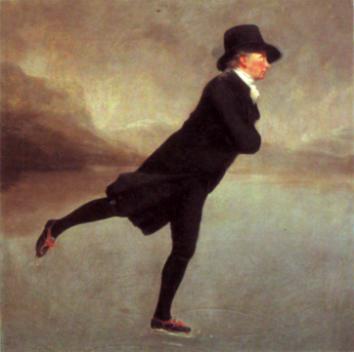
Scotland September 5th - 15th 2006
September 5-7 to stay with
anthropologists Sandy Robertson and his wife Francesca Bray, at their elegant roomy
flat in Edinburgh, only a 20-minute bus ride from the city centre. Sandy joined
our faculty at UCSB in 1985, Francesca a few years later. Sandy inherited two
of my courses, an undergraduate one on “Social change in Africa” and a graduate
seminar on “Development Anthropology”. Francesca is a leading authority on the
social and ecological history of China, the successor of the pioneering Joseph
Needham.
My
hosts, both keen walkers, arranged several outings, one a lovely long walk in
the Pentland Hills where black-faced sheep looked at us curiously, the rowan
trees were heavy with their red berries and where we ended up with yet another
good pub lunch. Sandy took me on a good circular walk in the Salisbury Crags,
where the first group of walkers we encountered proved to be South Africans.
I visited
the Scottish National Gallery, eager to see one of my favourite paintings,
Raeburn's Portrait of Reverend Robert Walker skating on
Duddingston Loch. But I was disconcerted to read notes suggesting that: (a)
the relocation was not actually, as alleged, Duddingston ; (b) the date was
incorrect, it probably having been painted 10 years later; and (c) worst of
all, that it was probably not by Raeburn himself.

From
there I climbed the hill to Edinburgh Castle to see, as recommended by my
prisoner-of-war friend Harry Mortlock, the Scottish National War Memorial. It
was quite a steep climb and before the last flight of steps a guide asked me if
I would like to use the lift. I declined, but when I entered the Memorial and
another attendant asked me “would you like a wee seat?” I gratefully accepted.

Sandy & Francesca
September 7 - 10. Caithness.
Deirdre & Peter Blackwood and Margaret Thurso. My connection with
this northernmost county of Britain arises through my eldest brother Guy, who
was stationed at Wick in 1940, while in the Fleet Air Arm, he fell in love
with and married Margaret Robertson,
their daughter Deirdre being born in
1942. Guy disappeared, in mysterious circumstances, from his aircraft carrier
in 1942, and 10 years later Margaret married Robin Sinclair, who became
Viscount Thurso. My first visit to Caithness was in May 1945. When my brother
Paul and I were released from our prisoner-of-war camp we went to Scotland at
the first opportunity, making the long and crowded train ride to meet Margaret and Deirdre. Bernard and I have
many happy memories of our visits to Caithness.
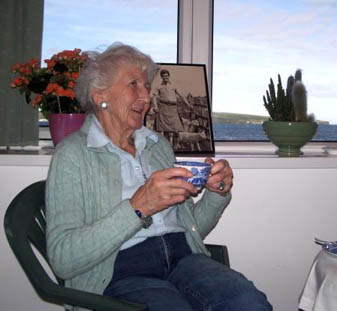
Margaret Thurso
Peter
Blackwood, Deirdre’s husband, met me at Inverness station and drove me (two
hours) to their home in Halkirk, a
small town eight miles from Thurso.
The
drive includes spectacular coastal scenery, and near Halkirk I was pleased to
see a large wind farm, proving that some attention is being paid to renewable
energy. During my visit I made a point of meeting as many as possible of Peter
and Deirdre’s five children and nine grandchildren. It was Bernard who used to
keep track of all our family, now 7 nieces and nephews, 21 greats and 18
great-greats. Deirdre had arranged several grand outings for me, including a
drive westwards, past the controversial nuclear reactor at Dounreay (presently
being de-commissioned, at great expense). We continued to Melvic for a pub
lunch, then turned south to the flow country, walking in the RSPB’s Forsinard
nature reserve where board walks make it easy to walk through the soggy –and
ecologically very diverse - peat country.
We
were shown around Castle Sinclair Gornigoe by its present owner, Malcolm, the
genial 20th Earl of Caithness, who enthusiastically told us its history - built
in the 14th century, severely damaged by Cromwell in the 17th century, and now
being restored by a team of archaeologists and builders. Walking precariously
and at great heights on the scaffolding, I was glad that American-style fear of
litigation did not apply here.
Another
outing, at my request, took us to Dalnawillan, the family hunting lodge way out
in the middle of the moors. Built in the 1820s, this imposing octagonal
structure, scene of countless happy gatherings, is now deserted and
deteriorating. When Bernard and I visited Dalnawillan in 1971, he had been very
apprehensive of Robin's formidable mother, Marigold, the Dowager Viscountess.
After dinner, which celebrated Robin's 50th birthday, we started to drive back
the 22 miles to Thurso Castle, where we were staying - the rest of the party
spending the night at Dalnawillan. Less than a mile from the lodge, Bernard
drove the car slightly off the road at a right-angled bend. The peaty turf was
too soft to give the jack any purchase, so I suggested that we return to the
lodge and wake Patrick, Margaret’s enterprising 15 year-old son, who, I felt
sure, would have found a tractor to pull us out. But Bernard, fearful of waking
Marigold by mistake, refused, so we walked all the way to Thurso. At 3am we
passed a lighted telephone booth, very close to Halkirk where Peter and Deirdre
lived. But when I suggested phoning them Bernard, very proper and English, said
“you can't phone people at this time of night”, so we completed our walk: a
memorable night.
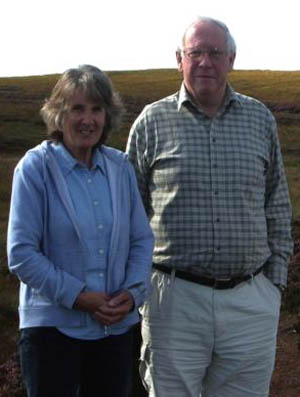 Deirdre & Peter
Deirdre & Peter
The
last time that Bernard and I had been at Dalnawillan was for Robin’s moving
funeral in 1995, when a lone bagpiper played the lament, leading the little procession up a hill to the small
family graveyard.
On
the way back from Dalnawillan on this present trip we stopped at Strathmore
Lodge to see Margaret’s son Patrick, who told us about the area –
Blar-nam-Faoleag - that he was managing. Later Peter found this description in
GOOGLE: 5500 acres of bog ecosystem… wild
blanket peat bog ….one of Europe's few remaining living peat bogs … taken 6000
years to develop…. the peat is 20 ft deep ….it is now threatened by development
and is a very sensitive system.
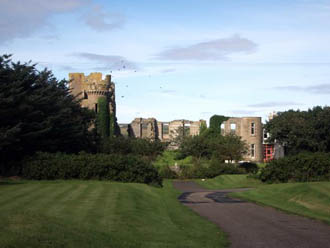
Thurso
Castle
Patrick
said that this land was popular with French hunters who liked to bring their
dogs over for exercise. They also liked to attempt to “do a McNab”, a term
originating in John Buchan's novel; it involves shooting a stag, catching a
salmon and bagging a brace of grouse, all in one day.( In fact, John Buchan
describes a McNab as involving only the first two feats: I do learn the most
extraordinary facts from my family). A few months after my visit, Deirdre
e-mailed me a photograph showing the damage caused by great floods in the area
– Strathmore Lodge was under three feet of water. Margaret later wrote that
“the river superintendent said that he had never seen such flooding of the
Thurso river in his lifetime”.
On
the Saturday evening I went to Mass in Thurso, where the jolly visiting priest
welcomed me as “David from South Africa” and I was proud of, instead of being
embarrassed by, my South African heritage. After Mass I took Peter and Deirdre
to one of the best meals I had on the entire trip, at Captain's Galley at Scrabster,
the harbour near Thurso. I liked this note in the menu: Tonight's fish was landed in Scrabster by the Shetland boat “Sunbeam”
on fishing grounds West of Shetlands… the lobster and crabs by “Bonnie Lad”
fishing the Neup Head grounds west of Orkney.………the fish was delicious.
Peter,
the factor for the Sinclair family trust estates, made me revise my ideas about
open access to the countryside, which at first I had thought a good idea. Peter
pointed out that landowners have serious problems when urban walkers leave
gates open, allow their dogs to harass livestock and fail to clear up their mess.
September 10 –
12 Thurso Margaret Thurso, took me to Castle Mey, which
she had often visited when the late Queen Mother was in residence, and Robin
was Lord-Lieutenant of the county. That
evening I was most impressed when Margaret not only had a dinner party for
eleven but did nearly everything herself, having no help in her charming
Archway Cottage. At that dinner, as at another one the previous evening, I met the
most interesting people and was so glad when Margaret always introduced me as
“my brother-in-law”, giving me the chance to talk about my hero, big brother
Guy.
September
12-13 After
the long train ride from Thurso to Edinburgh I broke my journey to spend
another evening with Sandy and Francesca.
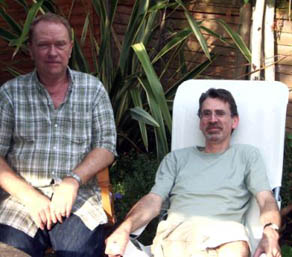 Kevin & Graham
Kevin & Graham
September
13-15. London Kevin Leeman & Graham
Hayter. When Bernard and I came to London in 1984, Clive Leeman (see Oct.
12) told us to see his twin brother Kevin, head of music at the Royal National
Theatre. We have seen Kevin and Graham ( a promoter of contemporary classical
music groups) frequently over the years; they visited me in 2004, shortly after
Bernard's death, and I am hoping that they will come again in 2007, when I’ll
be able to show them our wonderful display of spring wildflowers. We had our
wine (Flagstone Longitude, K & G
also having visited Appelsdrift) and
a braai in their garden - they live
in Hornsey/Crouch End, N8, - before a
light rain drove us indoors.
The
next day, Kevin drove me to Kennington to retrieve a bag, the London traffic
being much lighter than it was when we had been residents, thanks to Mayor Ken
Livingstone's introduction of a congestion charge, now £8 a day. Although I had not planned to see
sights, thinking I would be concentrating on meeting friends and family, I was
delighted by Kevin's suggestion that he take me to Keats’ House in Hampstead,
which I had never seen. (All along the way my hosts made similar thoughtful
gestures). The house was immensely rewarding - to be able to look at Keats’ desk and his bedroom, and to muse about
Fanny Brawne ; the explanatory notes were models in that they were easily
legible and gave enough information without deluging the reader.
That evening we went to the National Theatre for the
opening night of Ben Jonson's The Alchemist, with three distinguished
actors, Simon Russell Beale, Alex Jennings and Ian Richardson. Despite this
array of talent, all three of us were disappointed, finding that there was too
much “business”, and not enough emphasis on the text. The audience seemed
delighted, and the established critic Michael Billington gave it an
enthusiastic review in next day's Guardian.
Oh well.

September 15. An early minicab with a chatty Iranian driver took me to Heathrow,
arriving in good time because of the added security precautions. I got used to
the procedure - followed on all my subsequent flights except the last one from
Johannesburg to Cape Town - standing in a long line, removing my shoes, belt,
purse, cell-phone, carrying on a minimum of items - but all went quickly and I
was able to relax in the comfortable business-class lounge. To ensure that I
had in-flight reading I bought two novels at the airport bookstore - Ian McEwan Atonement and Amitav Ghosh The Hungry Tide (excellent choices).
NEXT - stage 3 East Coast USA Sept 15th - Oct 4th